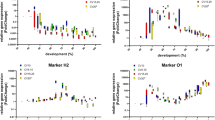Abstract
The age of a carrion insect associated with a corpse may represent a minimum postmortem interval. No method has been proposed before for constructing a confidence set on age based on development stage modeled as a categorical response. This paper illustrates the application of exact p values, first developed for succession data, to construct a confidence set on a carrion insect’s age based only on its development stage. It uses published development data for Lucilia sericata, with individuals reared at different temperatures pooled into sets of similar age as indexed in accumulated degree hours. Rates of coverage of true ages, assessed using each insect as a singleton holdout sample, were greater than the nominal 95% level.

Similar content being viewed by others
References
Adams, Z.J., Hall, M.J.R. (2003). Methods used for the killing and preservation of blowfly larvae, and their effect on post-mortem larval length. Forensic Science International 138:50-61.
Amendt, J., Campobasso, C.P., Gaudry, E., Reiter, C., LeBlanc, H.N., Hall, M.R.J. (2007). Best practice in forensic entomology - standards and guidelines. International Journal of Legal Medicine 121:90-104.
Baque, M., Filmann, N., Verhoff, M.A., Amendt, J. (2015). Establishment of developmental charts for the larvae of the blow fly Calliphora vicina using quantile regression. Forensic Science International 248:1-9.
Catts, E.P. (1990). Analyzing entomological data. In: Catts, E.P., Haskell, N.H. (Eds.), Entomology & Death: A Procedural Guide, pp. 24-35. Joyce’s Print Shop, Clemson, South Carolina.
Dadour, I.R., Cook, D.F., Wirth, N. (2001). Rate of development of Hydrotaea rostrata under summer and winter (cyclic and constant) temperature regimes. Medical and Veterinary Entomology 15:177-182.
Gaudry, E., Myskowiak, J-B., Chauvet, B., Pasquerault, T., Lefebvre, F., Malgorn, Y. (2001). Activity of the forensic entomology department of the French Gendarmerie. Forensic Science International 120:68-71.
Goff, M.L. (1993). Estimation of postmortem interval using arthropod development and succession patterns. Forensic Science Review 5:81-94.
Huntington, T., Higley, L. (2008). Collection and analysis of climatological data. In: Haskell, N.H., Williams, R.E. (Eds.), Entomology & Death: A Procedural Guide. 2nd edition, pp. 144-159. East Park Printing, Clemson, South Carolina.
Ieno, E.N., Amendt, J., Fremdt, H., Saveliev, A.A., Zuur, A.F. (2010). Analyzing forensic entomology data using additive mixed effects modeling. In: Amendt, J., Goff, M.L., Campobasso, C.P., Grassberger, M. (Eds.), Current Concepts in Forensic Entomology, pp.139-163. Springer, Heidelberg.
LaMotte, L.R., Wells, J.D. (2000). P-values for postmortem intervals from arthropod succession data. Journal of Agricultural, Biological and Environmental Statistics 5:37-47.
—— (2015). Inverse prediction for heteroscedastic response using mixed models software. Communications in Statistics – Simulation and Computation, accepted author version posted online 21 Nov. 2015. DOI:10.1080/03610918.2015.1118508.
—— (2016). Inverse prediction for multivariate mixed models with standard software. Statistical Papers 57(4):929-938. DOI:10.1007/s00362-016-0815-2.
Lehmann, E.L. (1986). Testing Statistical Hypotheses, Second Edition. John Wiley & Sons, Inc.
Midgley, J.M., Villet, M.H. (2009). Effect of the killing method on post-mortem change in length of larvae of Thanatophilus micans (Fabricius 1794) (Coleoptera: Silphidae) stored in 70% ethanol. International Journal of Legal Medicine 123:103-108.
National Research Council (2009). Strengthening Forensic Science in the United States, A Path Forward. National Academies Press, Washington.
Roe, A., Higley, L.G. (2015). Development modeling of Luciliasericata (Diptera: Calliphoridae). PeerJ 3:e803. DOI:10.7717/peerj.803.
SAS Institute Inc. (2012). SAS 9.4. Cary, N. C.
Tantawi, T.I., Greenberg, B. (1993). The effect of killing and preservative solutions on estimates of maggot age in forensic cases. Journal of Forensic Sciences 38:702-707.
Villet, M.H., Richards, C.S., Midgley, J.M. (2010). Contemporary precision, bias and accuracy of minimum post-mortem intervals estimated using development of carrion-feeding insects. In: Amendt, J., Goff, M.L., Campobasso, C.P., Grassberger, M. (Eds.), Current Concepts in Forensic Entomology, pp. 109-137. Springer, Heidelberg.
Wall, R., French, N., Morgan, K.L. (1992). Effects of temperature on the development and abundance of the sheep blowfly Lucilia sericata (Diptera: Calliphoridae). Bulletin of Entomological Research 82:125-131.
Wells, J.D. , LaMotte, L.R. (1995). Estimating maggot age from weight using inverse prediction. Journal of Forensic Sciences 40:585-590.
—— (2001). Estimating the postmortem interval. In: Byrd, J.H., Castner, J.L. (Eds.), Forensic Entomology, The Utility of Arthropods in Legal Investigations, 1st Edition, pp. 367-388. CRC Press, Boca Raton, Florida.
Wells, J.D., Lecheta, M.C., Moura, M.O., LaMotte, L.R. (2015). An evaluation of sampling methods used to produce insect growth models for postmortem interval estimation. International Journal of Legal Medicine 129:405-410.
Acknowledgements
This project was supported by Award Nos. 2013-DN-BX-K042 (LRL and JDW) and 2010-DN-BX-K231 (LGH), awarded by the National Institute of Justice, Office of Justice Programs, US Department of Justice. The opinions, findings, conclusions, or recommendations expressed in this publication are those of the authors and do not necessarily reflect those of the Department of Justice.
Author information
Authors and Affiliations
Corresponding author
Rights and permissions
About this article
Cite this article
LaMotte, L.R., Roe, A.L., Wells, J.D. et al. A Statistical Method to Construct Confidence Sets on Carrion Insect Age from Development Stage. JABES 22, 161–171 (2017). https://doi.org/10.1007/s13253-017-0280-y
Received:
Accepted:
Published:
Issue Date:
DOI: https://doi.org/10.1007/s13253-017-0280-y




